Basic Guide to Bedroom Lighting Decor
Creating the perfect lighting for your bedroom involves more than just picking out a few fixtures. It’s about understanding how different types of lighting work together to enhance the space. Here’s a basic guide to get you started:
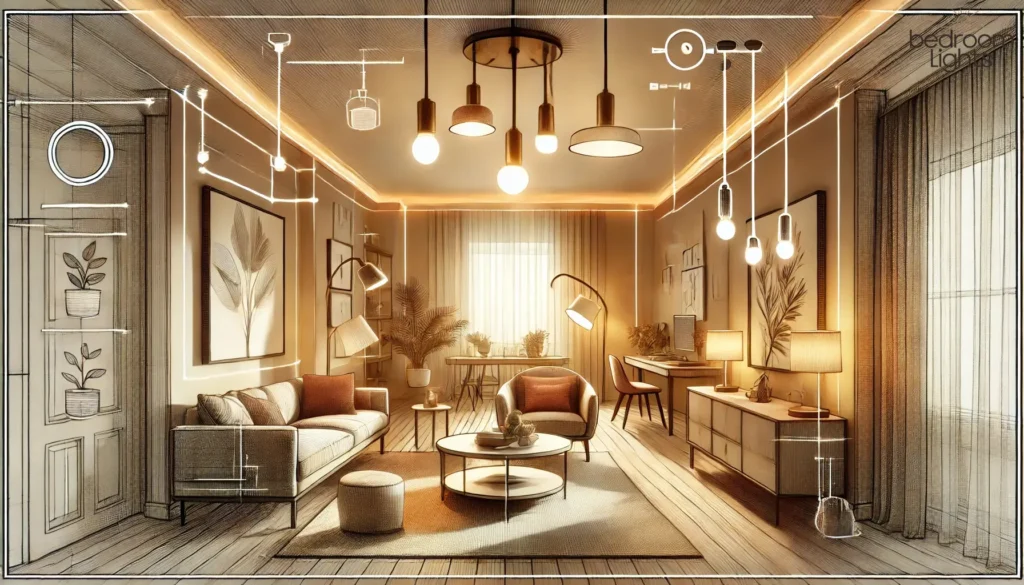
Understanding Lighting Layers
Effective bedroom lighting relies on layering different types of lighting to achieve a balanced and functional space. Each layer serves a distinct purpose:
Ambient Lighting: This is the primary source of illumination in your room. It provides general light that fills the entire space and ensures visibility throughout the room.
Common examples include ceiling lights like flush mounts or chandeliers, which offer broad, even lighting. Ambient lighting sets the foundation for other layers and creates a comfortable environment.
Task Lighting: Task lighting focuses on specific areas where you need additional light for particular activities. This could be reading, writing, or getting ready in the morning.
Bedside lamps, desk lamps, and adjustable reading lights are popular choices for task lighting. It’s essential that task lighting provides sufficient light without causing glare or strain.
Accent Lighting: Accent lighting adds visual interest by highlighting specific features or areas of the room. It creates depth and dimension, drawing attention to artwork, architectural details, or special decor items.
Examples include wall sconces, LED strips, and picture lights. Accent lighting helps to create a more dynamic and engaging space.
Decorative Lighting: This type of lighting serves primarily an aesthetic function, contributing to the room’s overall style and ambiance.
Decorative lighting includes options like string lights, fairy lights, or unique pendant fixtures. It adds a personal touch and enhances the room’s decor, making it feel more inviting and stylish.
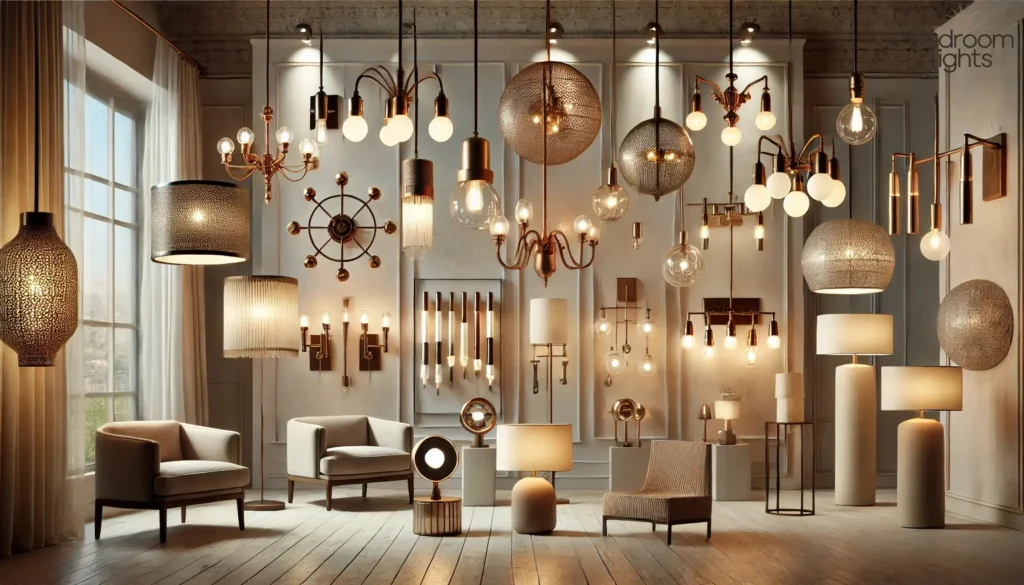
Choosing the Right Light Fixtures
Selecting the right fixtures is crucial to achieving the desired lighting effect. Here’s a breakdown of common fixture types and their considerations:
Ceiling Lights: Ceiling fixtures, such as flush mounts, pendant lights, or chandeliers, are essential for providing ambient lighting. The choice depends on your room’s size and ceiling height.
Flush mounts work well for lower ceilings, while chandeliers or pendant lights add elegance to higher ceilings. Ensure that the fixture is appropriately sized for the room to avoid overwhelming or underlighting the space.
Lamps: Lamps are versatile and can be used for both task and decorative lighting. Table lamps are ideal for bedside tables or desks, offering focused light for reading or working.
Floor lamps can add height and visual interest, while adjustable lamps allow for customizable lighting angles. Choose lamps that match your room’s style and provide adequate light for their intended purpose.
Wall Sconces: Wall sconces are a stylish option for both ambient and accent lighting. They can be used to frame a bed, highlight artwork, or provide soft, indirect light.
Consider the sconce’s design and placement to complement your room’s decor and enhance its functionality.
When choosing light fixtures, consider both functionality and style. Opt for fixtures that not only meet your lighting needs but also align with your room’s aesthetic. Think about the room’s size, layout, and existing decor to ensure that your lighting choices enhance the space rather than detract from it.
By understanding and combining these lighting layers and selecting the right fixtures, you can create a well-lit, beautifully styled bedroom that meets both your practical needs and aesthetic preferences.
Decor Lights
When it comes to decorating your bedroom, lighting plays a pivotal role in creating an inviting and aesthetically pleasing atmosphere. Each type of lighting serves a specific function and contributes to the overall look and feel of the space.
Here’s a breakdown of different decor lights and how they can enhance your bedroom:
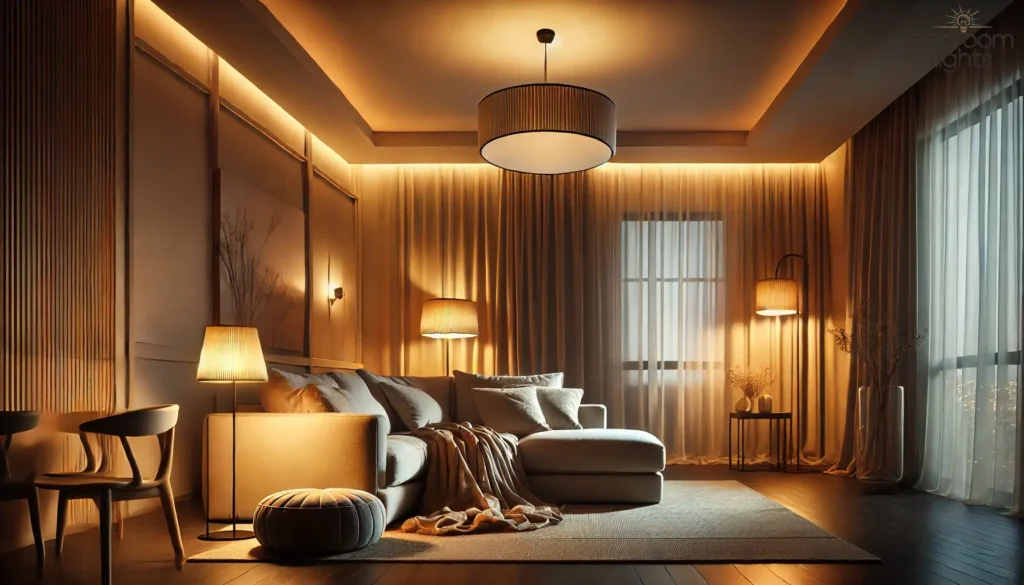
Ambient Lighting
Overview: Ambient lighting provides the primary source of illumination for your bedroom, ensuring that the space is well-lit and functional. It creates an even light distribution throughout the room, setting the foundation for other lighting layers.
Examples:
Overhead Fixtures: These include ceiling-mounted lights like flush mounts, chandeliers, or pendant lights. Flush mounts are ideal for rooms with lower ceilings, providing a clean, unobtrusive look. Chandeliers or pendant lights add elegance and a focal point to higher ceilings.
Ceiling Fans with Lights: Combining functionality with style, ceiling fans with integrated lighting offer both cooling and illumination. They are especially useful in rooms where space is limited and can be a practical choice for maintaining comfort while adding to the decor.
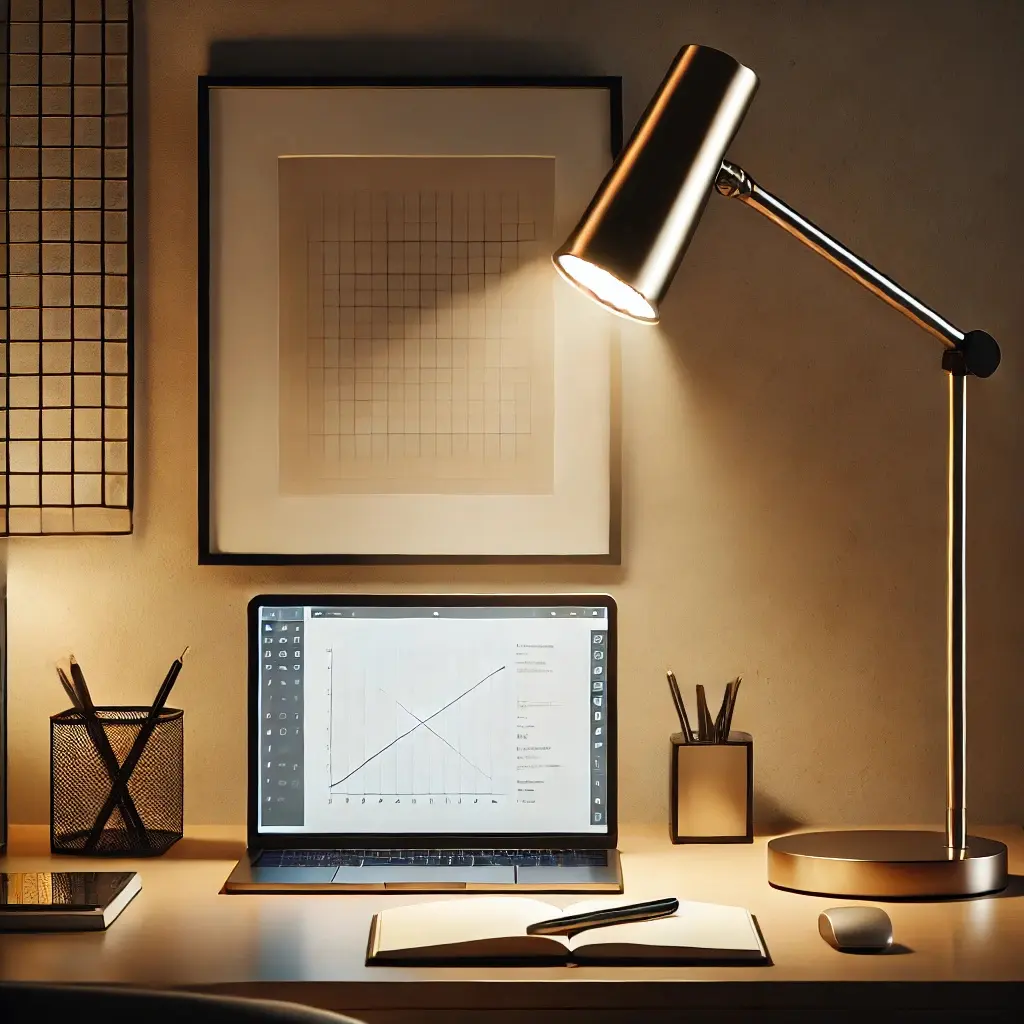
Task Lighting
Purpose: Task lighting focuses on specific areas where you need additional light for activities such as reading, studying, or getting ready. It ensures that these areas are well-lit and functional, minimizing eye strain and improving visibility.
Examples:
Bedside Lamps: Positioned on nightstands or bedside tables, these lamps provide focused light for reading or nighttime tasks. They come in various styles, from modern to classic, and can include adjustable arms or dimming features for added convenience.
Desk Lamps: Ideal for work or study areas, desk lamps offer directed light for tasks that require precision and concentration. Look for options with adjustable necks and brightness settings to customize the lighting to your needs.
Reading Lights: Mounted on the wall or attached to the headboard, reading lights are designed to provide focused light without disturbing your partner. They are perfect for creating a cozy reading nook by the bed.
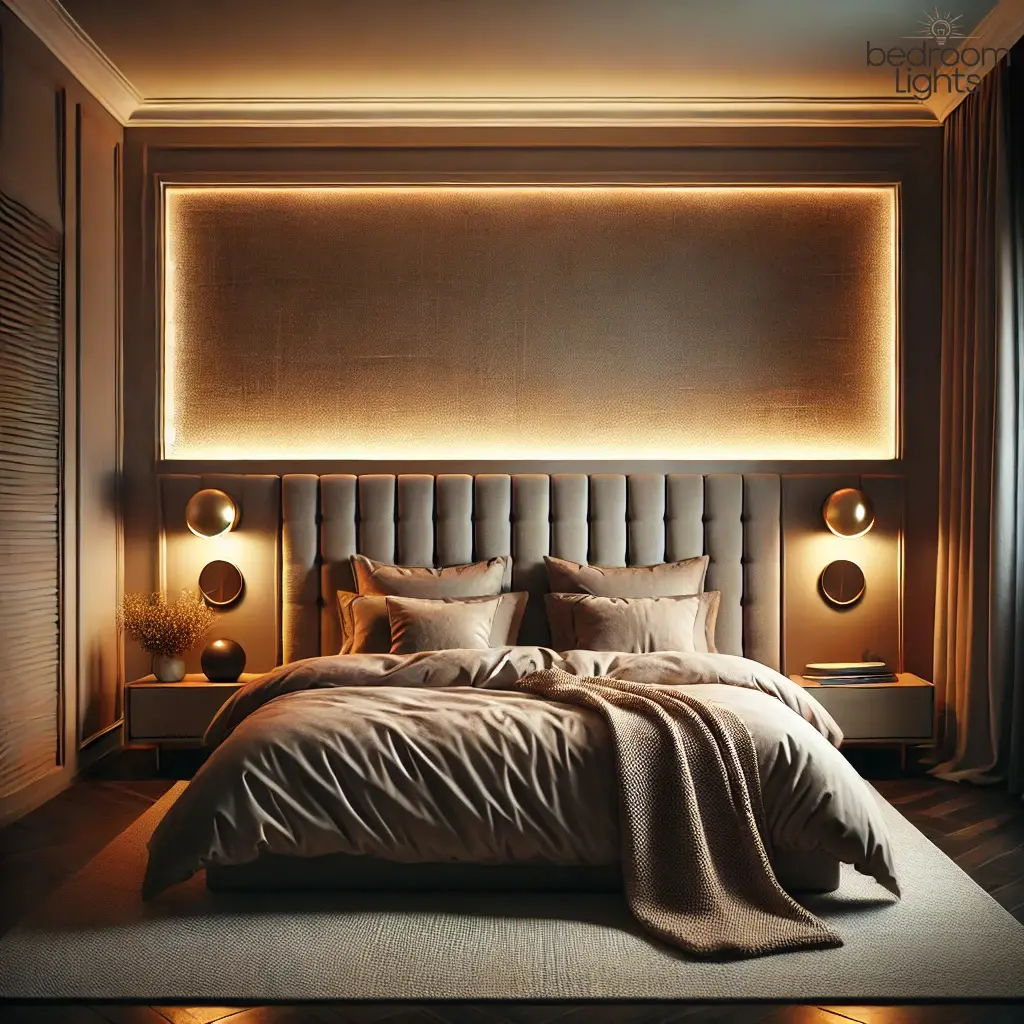
Accent Lighting
Uses: Accent lighting adds depth and visual interest to your bedroom by highlighting specific features or creating focal points. It enhances the room’s decor and adds a touch of drama or elegance.
Examples:
LED Strips: Flexible and versatile, LED strips can be installed under furniture, along shelves, or behind headboards to create a glowing effect. They come in various colors and can be adjusted for brightness, making them perfect for creating ambiance or highlighting architectural features.
Picture Lights: These are designed to illuminate artwork or photographs, drawing attention to your favorite pieces and adding a sophisticated touch. They can be wall-mounted or installed directly above the artwork.
Wall Sconces: Wall sconces add both functionality and style, providing soft, indirect light that can enhance the room’s atmosphere. They are often used to frame a bed or accentuate architectural details.
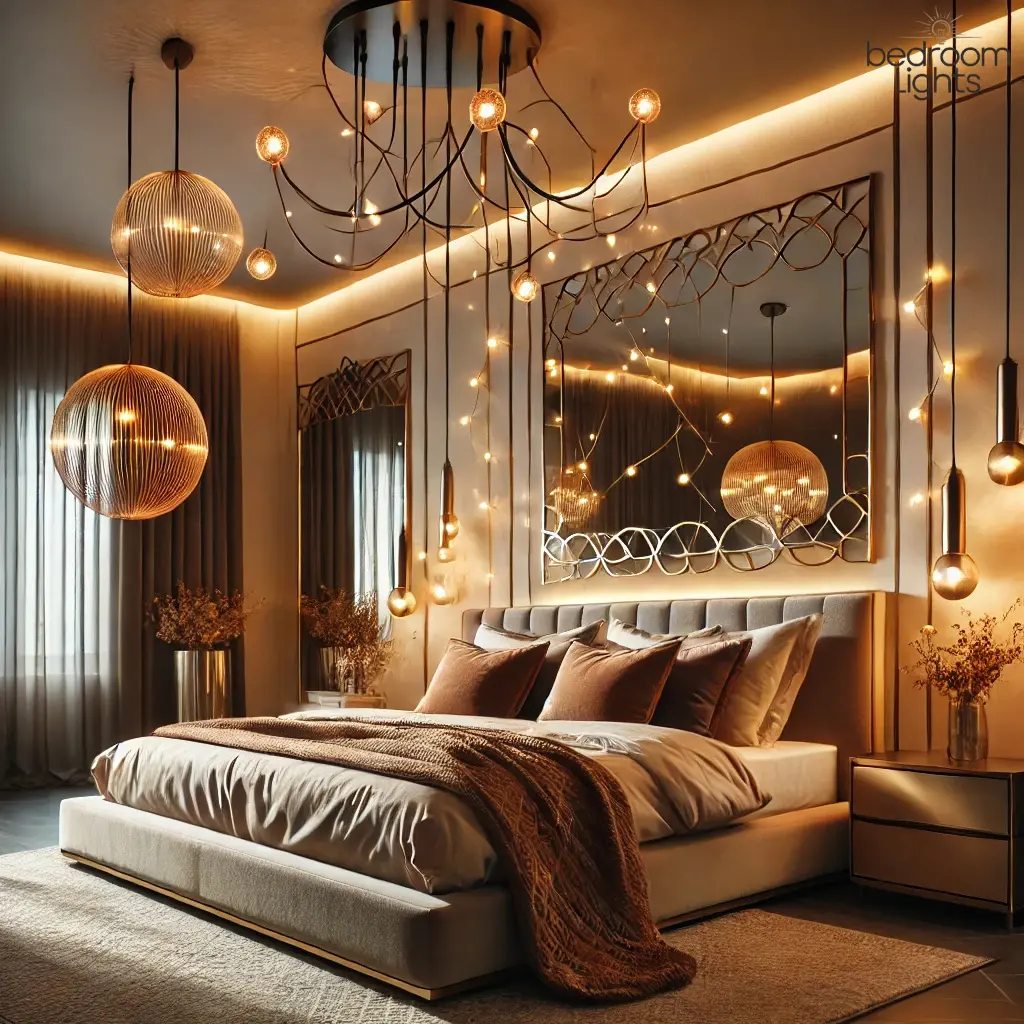
Decorative Lighting
Examples: Decorative lighting is all about adding a personal touch and enhancing the overall aesthetic of your bedroom. It creates visual appeal and adds a whimsical or elegant element to the space.
Fairy Lights: These tiny, twinkling lights can be draped around the bed frame, hung along walls, or placed in jars for a magical, cozy effect. They are versatile and can be used to create a soft, enchanting ambiance.
String Lights: Similar to fairy lights but often with larger bulbs, string lights can be used to add warmth and charm. They work well when draped along the headboard, around windows, or as a canopy over the bed.
Unique Fixtures: One-of-a-kind lighting fixtures, such as decorative pendants or sculptural lamps, can serve as statement pieces in your bedroom. Choose fixtures that reflect your personal style and become focal points in the room.
By incorporating these various types of decor lights, you can enhance your bedroom’s functionality and style, creating a space that is both beautifully lit and uniquely your own.
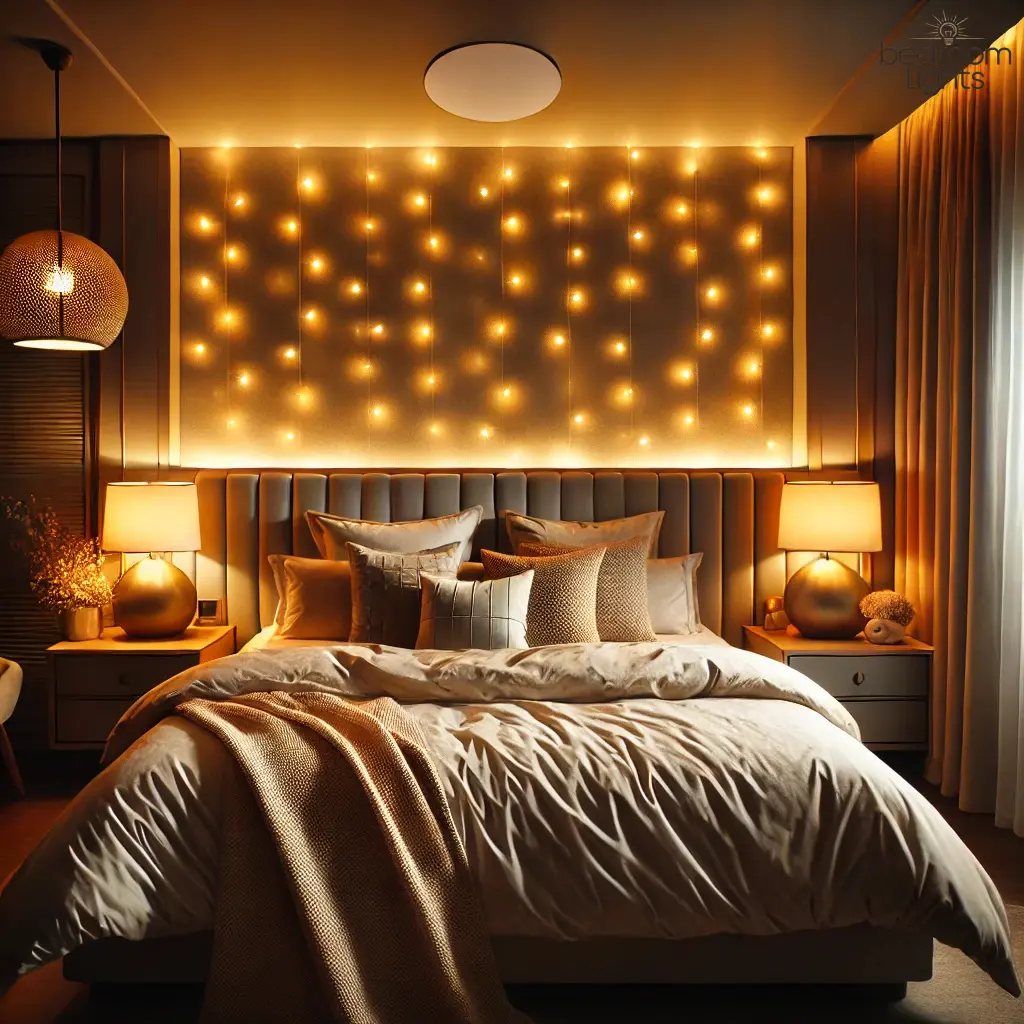
Creating a Perfectly Lit Bedroom
Designing the perfect lighting for your bedroom involves more than simply choosing light fixtures. It requires a thoughtful approach to layering different types of lighting, adjusting brightness levels, selecting the right color temperature, and ensuring practical placement.
Here’s how you can create a beautifully lit and functional bedroom:
Layering Lighting
Combining Ambient, Task, and Accent Lighting Effectively:
To achieve a well-lit and balanced space, you need to layer your lighting. Each layer serves a specific purpose and contributes to the overall ambiance:
Ambient Lighting: This provides the general illumination needed for everyday activities and sets the tone for the room. It should be the foundation of your lighting plan.
Task Lighting: Focuses on areas where detailed work is done. Place bedside lamps for reading or desk lamps for work to ensure these areas are well-lit and functional.
Accent Lighting: Adds visual interest and highlights specific features or decor elements. Use LED strips to illuminate shelves, picture lights to showcase artwork, or wall sconces to frame the bed.
By combining these layers, you create a dynamic and versatile lighting setup that enhances both the functionality and aesthetics of your bedroom.
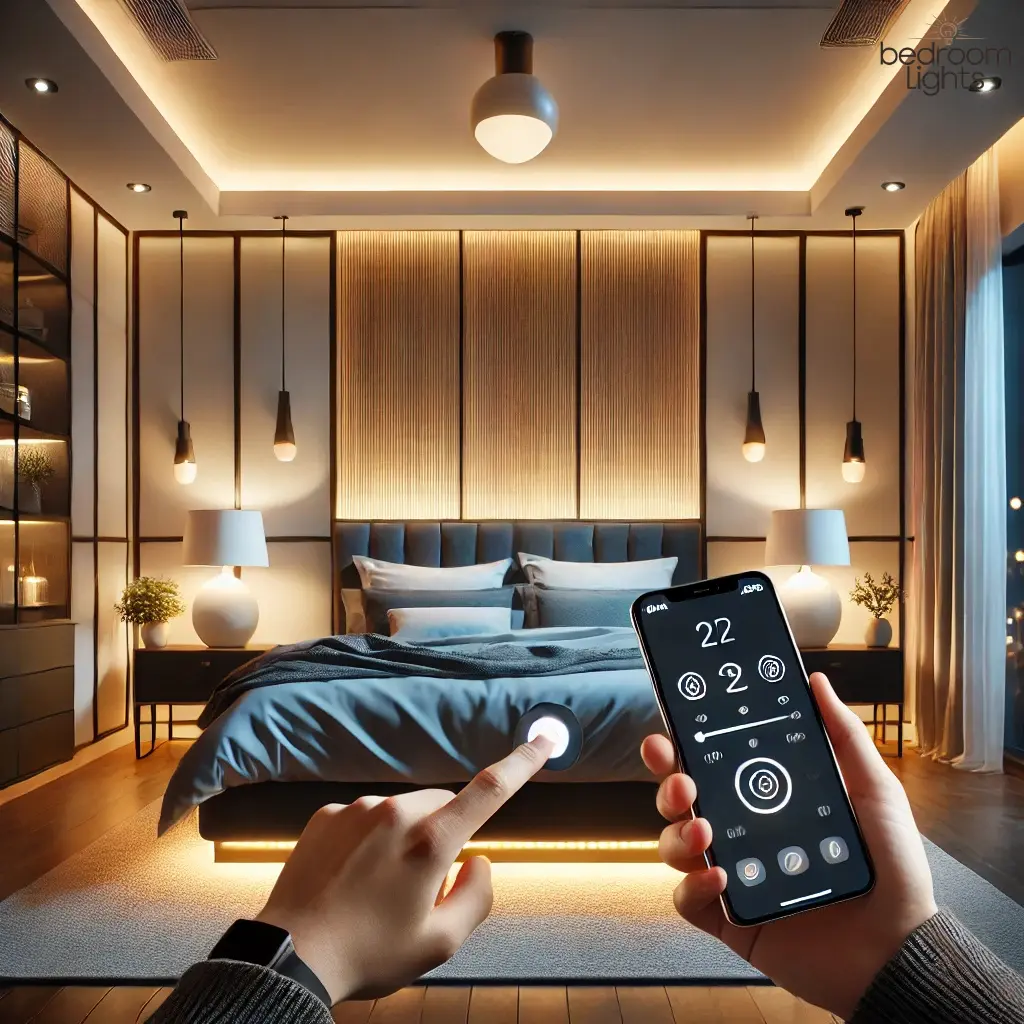
Adjustable Lighting Options
Dimmer Switches:
Dimmer switches allow you to adjust the brightness of your lights according to your needs and mood. They are particularly useful for creating a relaxing environment in the evening or providing bright light for reading or other tasks.
Install dimmers on your ambient and task lighting to easily switch between different light levels.
Smart Lighting Controls:
Smart lighting systems offer advanced control over your bedroom’s lighting. With options for color changes, schedules, and remote control via smartphone apps, you can customize your lighting experience effortlessly.
For example, you can set your lights to gradually dim as you prepare for sleep or adjust colors to match your desired mood.
Color Temperature
Choosing Between Warm and Cool Light:
The color temperature of your lights affects the mood and functionality of your bedroom.
Warm Light: Ranges from 2700K to 3000K and creates a cozy, inviting atmosphere. It’s ideal for creating a relaxing environment and works well in areas where you unwind, like near the bed or in reading nooks.
Cool Light: Ranges from 4000K to 5000K and provides a crisp, bright illumination that enhances focus and energy. It’s suitable for task lighting, such as desk lamps or reading lights, where clear visibility is essential.
By selecting the right color temperature for each type of lighting, you can tailor the ambiance of your room to suit various activities and times of day.
Practical Placement Tips
Optimal Locations for Different Lighting Types:
Ambient Lighting: Place central fixtures like ceiling lights or chandeliers in the center of the room to ensure even light distribution. For larger rooms, consider multiple light sources to avoid dark corners.
Task Lighting: Position bedside lamps at a comfortable height and distance from your bed to avoid straining your eyes. Desk lamps should be placed to illuminate work areas without causing glare.
Accent Lighting: Install LED strips or picture lights to highlight specific features, such as artwork or architectural details. Ensure they are positioned to create the desired effect without overwhelming the space.
Avoiding Glare and Ensuring Even Light Distribution:
Glare: Use shades or diffusers to soften harsh light and reduce glare. Avoid placing lights directly in your line of sight or where they might create uncomfortable reflections.
Even Light Distribution: Combine different types of lighting to achieve a balanced illumination. Ensure that ambient lighting fills the room evenly, while task and accent lighting enhance specific areas without leaving dark spots.
By thoughtfully layering your lighting, using adjustable options, selecting the right color temperature, and placing fixtures strategically, you can create a perfectly lit bedroom that is both functional and beautifully styled.
Beautiful Room Lighting Settings
Lighting plays a crucial role in shaping the ambiance and style of your bedroom. By tailoring your lighting to match different design styles, creating the right mood, and highlighting key decor elements, you can transform your space into a beautifully lit haven.
Here’s how to achieve stunning lighting settings for your bedroom:
Designing for Different Styles
Modern:
Modern bedrooms often feature sleek, minimalist designs with clean lines and neutral color palettes. For a modern look:
Lighting Fixtures: Choose simple, geometric fixtures like pendant lights or track lighting with a polished finish. Recessed lights or flush mounts offer a clean look without overpowering the space.
Features: Opt for fixtures with innovative designs or integrated LEDs to maintain a streamlined appearance. Consider using color-changing LEDs to add versatility.
Traditional:
Traditional bedrooms embrace classic elegance and timeless designs. To enhance a traditional style:
Lighting Fixtures: Incorporate ornate chandeliers, elegant sconces, or classic table lamps with detailed bases and shades. Brass or bronze finishes often complement traditional decor.
Features: Choose fixtures with intricate designs or vintage touches, such as fabric lampshades and decorative crystal elements, to add sophistication and charm.
Cozy/Rustic:
A cozy or rustic bedroom exudes warmth and comfort with natural materials and textures. For this style:
Lighting Fixtures: Use fixtures made of wood, wrought iron, or antique finishes. Lantern-style lights, exposed bulb fixtures, or rustic pendant lights fit well with this aesthetic.
Features: Opt for warm, soft light to enhance the inviting feel. Consider adding dimmers to adjust the light intensity and create a snug atmosphere.
Contemporary:
Contemporary bedrooms are known for their modern aesthetic with a focus on current trends. To achieve a contemporary look:
Lighting Fixtures: Select bold, artistic fixtures such as sculptural pendant lights or unique floor lamps. Clean lines and metallic finishes can complement the modern decor.
Features: Use smart lighting options to allow for customization and flexibility. Consider fixtures that combine functionality with design, such as multi-purpose lamps with adjustable settings.
Creating Ambiance
Using Lighting to Set a Relaxing or Energizing Mood:
Relaxing Mood: Soft, warm lighting creates a tranquil environment. Use dimmable fixtures, table lamps with warm bulbs, or string lights to achieve a calming ambiance. Incorporate a combination of indirect lighting and low-intensity sources to create a serene atmosphere perfect for winding down.
Energizing Mood: Bright, cool lighting can invigorate and energize the space. Use ceiling lights with high lumen output, cool-toned bulbs, or LED strips to enhance alertness and focus. Bright task lighting can also make the room feel more lively and active.
Highlighting Decor Elements
Accentuating Artwork, Architectural Features, or Furniture:
Artwork: Use picture lights or adjustable spotlights to illuminate artwork and create a focal point. Ensure the light is directed to highlight the piece without causing glare or reflection.
Architectural Features: Highlight architectural elements such as moldings, built-ins, or ceiling details with accent lighting. Recessed lights or LED strips can be installed to draw attention to these features and enhance their visual impact.
Furniture: Use accent lighting to showcase unique furniture pieces or create a visual hierarchy in the room. For example, place LED strips under a floating bed or highlight a statement headboard with wall sconces to make the furniture stand out.
By thoughtfully designing your lighting to match your style, setting the right mood, and emphasizing key decor elements, you can create a beautifully lit bedroom that enhances both its functionality and aesthetic appeal.
Additional Tips
To truly personalize your bedroom lighting ideas and ensure it remains in top condition, consider these additional tips:
DIY Lighting Ideas
Customizing or Creating Unique Lighting Solutions:
Mason Jar Lights: Transform simple mason jars into charming light fixtures. Fill jars with string lights or LED bulbs, and hang them in clusters for a whimsical touch. You can also use painted jars or add decorative elements like ribbons to match your decor.
Upcycled Fixtures: Repurpose old items into creative lighting solutions. For instance, turn an antique colander into a pendant light by attaching it to a lamp kit, or use an old ladder as a base for string lights. This not only adds a unique flair to your room but also gives new life to forgotten objects.
Custom Lampshades: Personalize your lamp shades with fabric paint, decals, or patterned paper. This is an easy way to add a custom touch to your lighting fixtures without having to replace them entirely.
Floating Shelves with LED Strips: Install floating shelves and add LED strips underneath them for a sleek, modern look. This setup not only provides practical lighting for the shelves but also creates an elegant, floating effect.
Maintaining Your Lighting
Cleaning Fixtures, Checking Bulb Life, and Ensuring Safety:
Cleaning Fixtures: Regularly dust and clean your light fixtures to maintain their brightness and appearance. Use a soft cloth and a mild cleaner suitable for the fixture’s material. For hard-to-reach fixtures, consider using a vacuum with a soft brush attachment.
Checking Bulb Life: Monitor the condition of your light bulbs and replace them as needed. Keep track of the expected lifespan of different bulbs (e.g., incandescent, LED) and replace them before they burn out to ensure consistent lighting and avoid potential damage to fixtures.
Ensuring Safety: Ensure all electrical connections are secure and that wiring is properly maintained. Avoid overloading circuits and use the correct wattage for your light fixtures. If you experience flickering lights or notice any issues with your electrical system, consult a professional electrician to address potential problems.
By incorporating these DIY lighting ideas, you can create unique, personalized solutions that reflect your style and add character to your bedroom. Additionally, regular maintenance will help keep your lighting in optimal condition, ensuring it remains both beautiful and functional for years to come.
